Accounting Principles: Financial Statement Analysis of BAJ Shop
VerifiedAdded on 2023/06/09
|19
|4347
|348
Report
AI Summary
This report provides a comprehensive financial analysis of BAJ Shop, applying key accounting principles to evaluate its performance and inform decision-making. The analysis includes the computation of financial statements such as the Trading Account, Profit and Loss Account, and Balance Sheet. Furthermore, it involves the calculation and comparison of various financial ratios, including profitability ratios (Gross Profit Margin, Net Profit Ratio), liquidity ratios (Current Ratio, Quick Ratio), and efficiency ratios (Inventory Turnover Ratio) across multiple years to assess the company's revenue generation ability, short-term solvency, and operational efficiency. The report also discusses the role of accounting in meeting business, societal, and stakeholder requirements, ethical constraints, and the significance of risk management, reputation, sustainability, and governance. Additionally, the report covers partnership trading accounts, profit & loss accounts, balance sheets, income statements, and cash budgets, providing a holistic view of financial management and analysis within the context of BAJ Shop and similar business enterprises; solved examples available on Desklib.
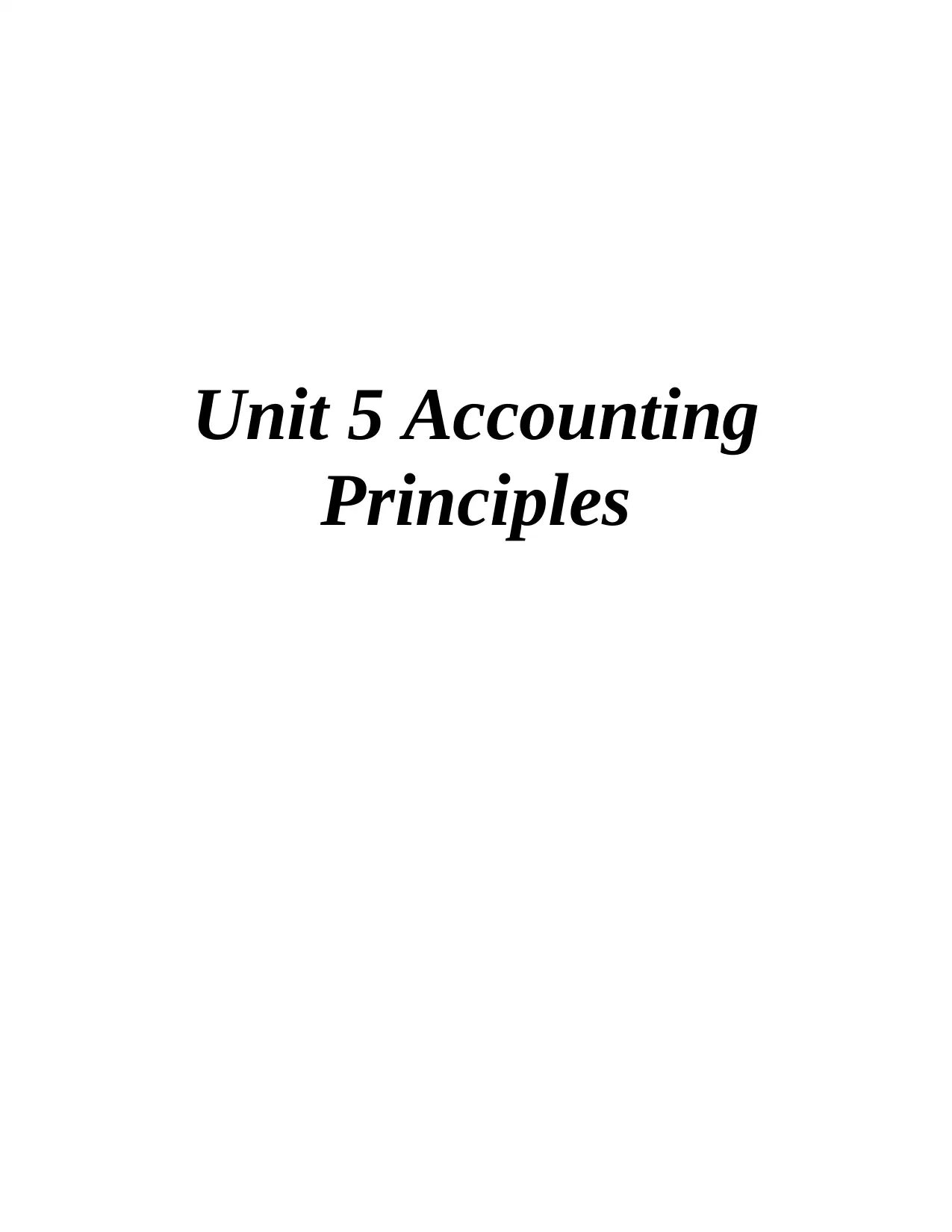
Unit 5 Accounting
Principles
Principles
Paraphrase This Document
Need a fresh take? Get an instant paraphrase of this document with our AI Paraphraser
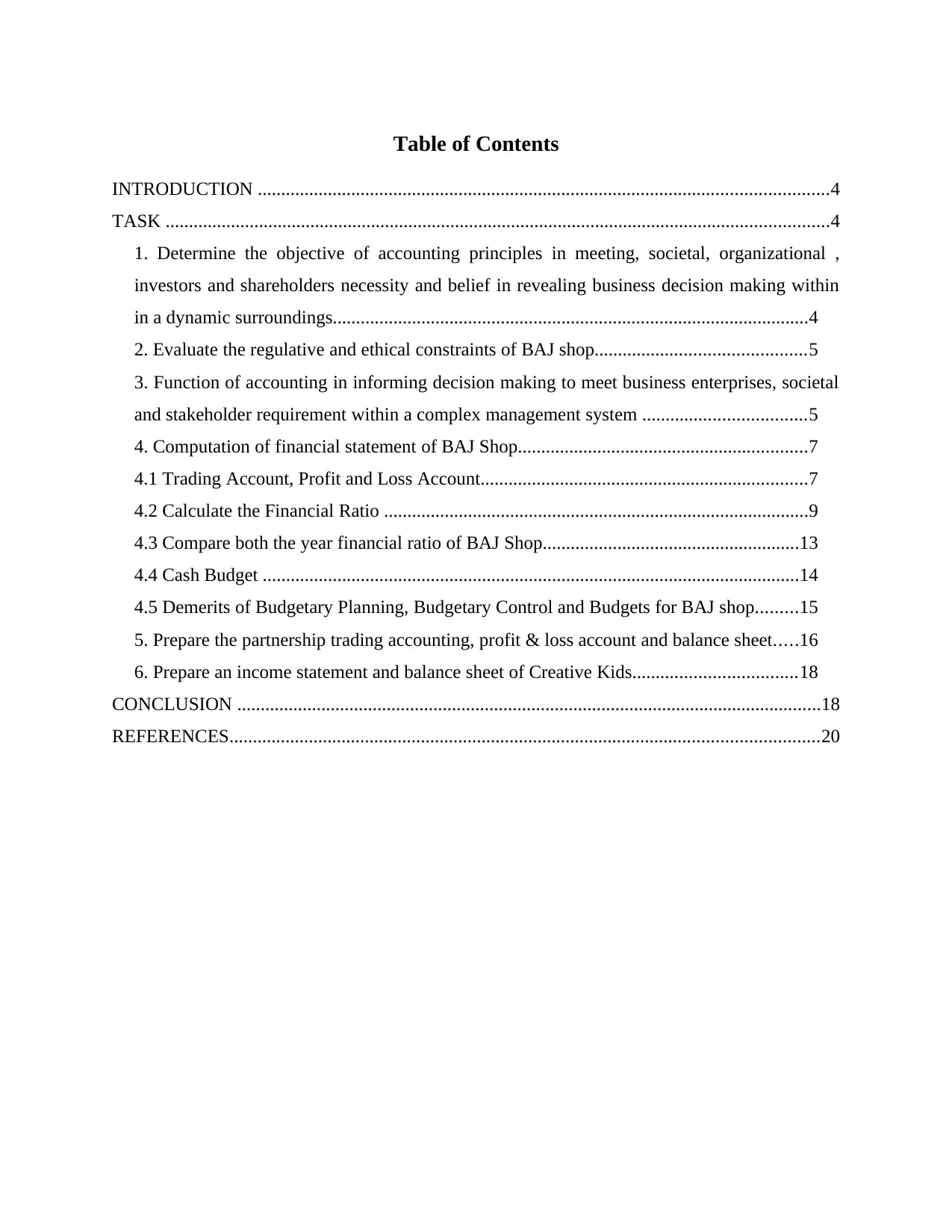
Table of Contents
INTRODUCTION ..........................................................................................................................4
TASK ..............................................................................................................................................4
1. Determine the objective of accounting principles in meeting, societal, organizational ,
investors and shareholders necessity and belief in revealing business decision making within
in a dynamic surroundings......................................................................................................4
2. Evaluate the regulative and ethical constraints of BAJ shop.............................................5
3. Function of accounting in informing decision making to meet business enterprises, societal
and stakeholder requirement within a complex management system ...................................5
4. Computation of financial statement of BAJ Shop..............................................................7
4.1 Trading Account, Profit and Loss Account......................................................................7
4.2 Calculate the Financial Ratio ...........................................................................................9
4.3 Compare both the year financial ratio of BAJ Shop.......................................................13
4.4 Cash Budget ...................................................................................................................14
4.5 Demerits of Budgetary Planning, Budgetary Control and Budgets for BAJ shop.........15
5. Prepare the partnership trading accounting, profit & loss account and balance sheet.....16
6. Prepare an income statement and balance sheet of Creative Kids...................................18
CONCLUSION .............................................................................................................................18
REFERENCES..............................................................................................................................20
INTRODUCTION ..........................................................................................................................4
TASK ..............................................................................................................................................4
1. Determine the objective of accounting principles in meeting, societal, organizational ,
investors and shareholders necessity and belief in revealing business decision making within
in a dynamic surroundings......................................................................................................4
2. Evaluate the regulative and ethical constraints of BAJ shop.............................................5
3. Function of accounting in informing decision making to meet business enterprises, societal
and stakeholder requirement within a complex management system ...................................5
4. Computation of financial statement of BAJ Shop..............................................................7
4.1 Trading Account, Profit and Loss Account......................................................................7
4.2 Calculate the Financial Ratio ...........................................................................................9
4.3 Compare both the year financial ratio of BAJ Shop.......................................................13
4.4 Cash Budget ...................................................................................................................14
4.5 Demerits of Budgetary Planning, Budgetary Control and Budgets for BAJ shop.........15
5. Prepare the partnership trading accounting, profit & loss account and balance sheet.....16
6. Prepare an income statement and balance sheet of Creative Kids...................................18
CONCLUSION .............................................................................................................................18
REFERENCES..............................................................................................................................20
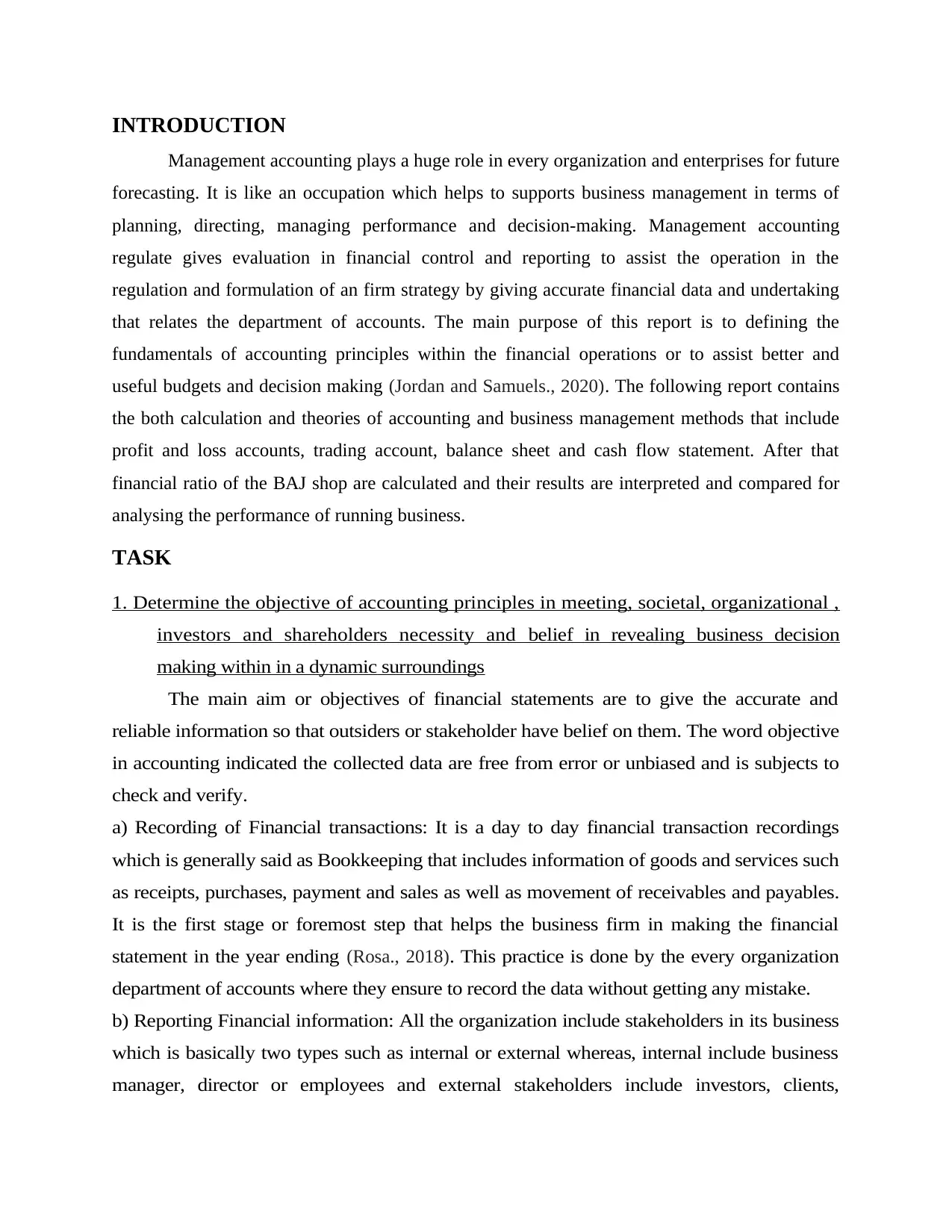
INTRODUCTION
Management accounting plays a huge role in every organization and enterprises for future
forecasting. It is like an occupation which helps to supports business management in terms of
planning, directing, managing performance and decision-making. Management accounting
regulate gives evaluation in financial control and reporting to assist the operation in the
regulation and formulation of an firm strategy by giving accurate financial data and undertaking
that relates the department of accounts. The main purpose of this report is to defining the
fundamentals of accounting principles within the financial operations or to assist better and
useful budgets and decision making (Jordan and Samuels., 2020). The following report contains
the both calculation and theories of accounting and business management methods that include
profit and loss accounts, trading account, balance sheet and cash flow statement. After that
financial ratio of the BAJ shop are calculated and their results are interpreted and compared for
analysing the performance of running business.
TASK
1. Determine the objective of accounting principles in meeting, societal, organizational ,
investors and shareholders necessity and belief in revealing business decision
making within in a dynamic surroundings
The main aim or objectives of financial statements are to give the accurate and
reliable information so that outsiders or stakeholder have belief on them. The word objective
in accounting indicated the collected data are free from error or unbiased and is subjects to
check and verify.
a) Recording of Financial transactions: It is a day to day financial transaction recordings
which is generally said as Bookkeeping that includes information of goods and services such
as receipts, purchases, payment and sales as well as movement of receivables and payables.
It is the first stage or foremost step that helps the business firm in making the financial
statement in the year ending (Rosa., 2018) . This practice is done by the every organization
department of accounts where they ensure to record the data without getting any mistake.
b) Reporting Financial information: All the organization include stakeholders in its business
which is basically two types such as internal or external whereas, internal include business
manager, director or employees and external stakeholders include investors, clients,
Management accounting plays a huge role in every organization and enterprises for future
forecasting. It is like an occupation which helps to supports business management in terms of
planning, directing, managing performance and decision-making. Management accounting
regulate gives evaluation in financial control and reporting to assist the operation in the
regulation and formulation of an firm strategy by giving accurate financial data and undertaking
that relates the department of accounts. The main purpose of this report is to defining the
fundamentals of accounting principles within the financial operations or to assist better and
useful budgets and decision making (Jordan and Samuels., 2020). The following report contains
the both calculation and theories of accounting and business management methods that include
profit and loss accounts, trading account, balance sheet and cash flow statement. After that
financial ratio of the BAJ shop are calculated and their results are interpreted and compared for
analysing the performance of running business.
TASK
1. Determine the objective of accounting principles in meeting, societal, organizational ,
investors and shareholders necessity and belief in revealing business decision
making within in a dynamic surroundings
The main aim or objectives of financial statements are to give the accurate and
reliable information so that outsiders or stakeholder have belief on them. The word objective
in accounting indicated the collected data are free from error or unbiased and is subjects to
check and verify.
a) Recording of Financial transactions: It is a day to day financial transaction recordings
which is generally said as Bookkeeping that includes information of goods and services such
as receipts, purchases, payment and sales as well as movement of receivables and payables.
It is the first stage or foremost step that helps the business firm in making the financial
statement in the year ending (Rosa., 2018) . This practice is done by the every organization
department of accounts where they ensure to record the data without getting any mistake.
b) Reporting Financial information: All the organization include stakeholders in its business
which is basically two types such as internal or external whereas, internal include business
manager, director or employees and external stakeholders include investors, clients,
⊘ This is a preview!⊘
Do you want full access?
Subscribe today to unlock all pages.

Trusted by 1+ million students worldwide
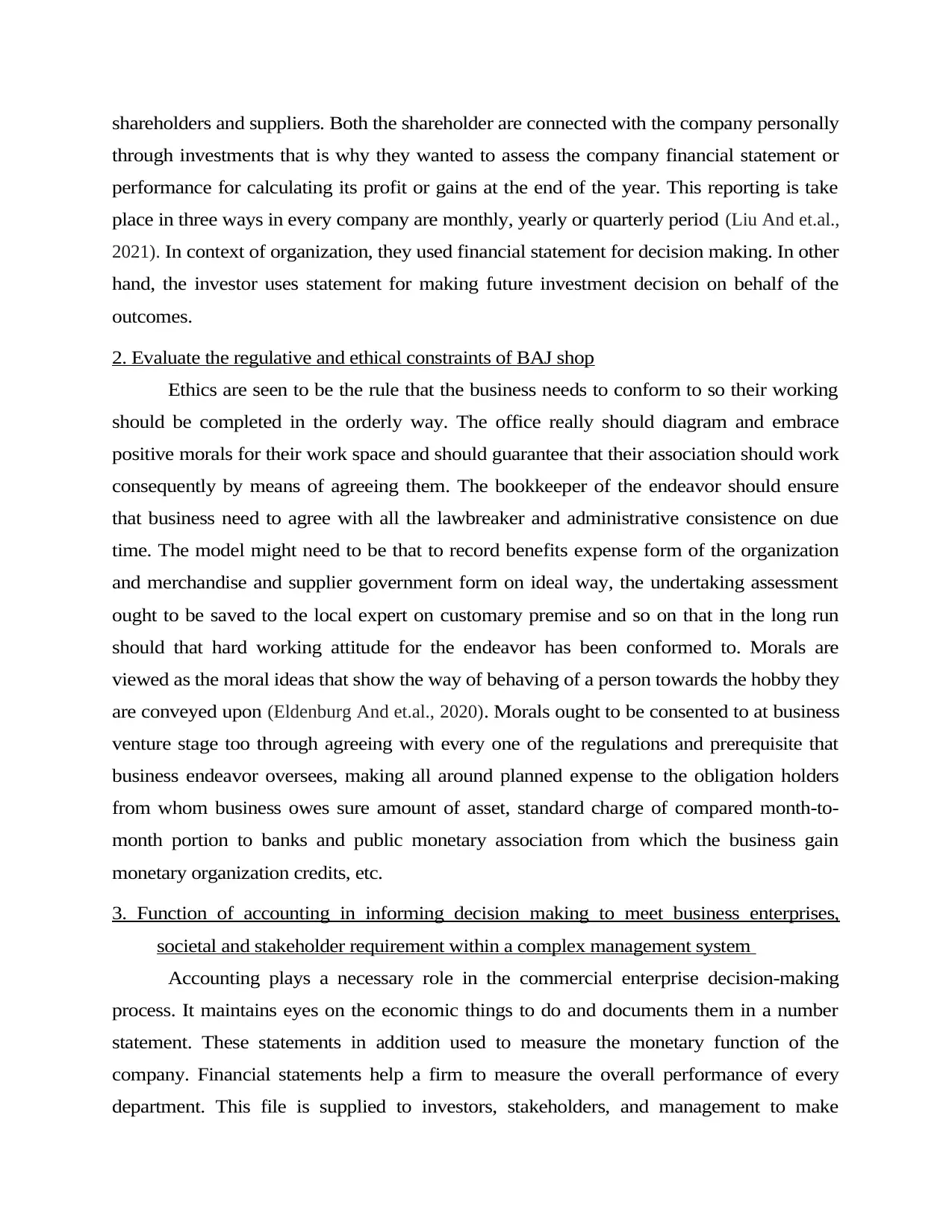
shareholders and suppliers. Both the shareholder are connected with the company personally
through investments that is why they wanted to assess the company financial statement or
performance for calculating its profit or gains at the end of the year. This reporting is take
place in three ways in every company are monthly, yearly or quarterly period (Liu And et.al.,
2021). In context of organization, they used financial statement for decision making. In other
hand, the investor uses statement for making future investment decision on behalf of the
outcomes.
2. Evaluate the regulative and ethical constraints of BAJ shop
Ethics are seen to be the rule that the business needs to conform to so their working
should be completed in the orderly way. The office really should diagram and embrace
positive morals for their work space and should guarantee that their association should work
consequently by means of agreeing them. The bookkeeper of the endeavor should ensure
that business need to agree with all the lawbreaker and administrative consistence on due
time. The model might need to be that to record benefits expense form of the organization
and merchandise and supplier government form on ideal way, the undertaking assessment
ought to be saved to the local expert on customary premise and so on that in the long run
should that hard working attitude for the endeavor has been conformed to. Morals are
viewed as the moral ideas that show the way of behaving of a person towards the hobby they
are conveyed upon (Eldenburg And et.al., 2020) . Morals ought to be consented to at business
venture stage too through agreeing with every one of the regulations and prerequisite that
business endeavor oversees, making all around planned expense to the obligation holders
from whom business owes sure amount of asset, standard charge of compared month-to-
month portion to banks and public monetary association from which the business gain
monetary organization credits, etc.
3. Function of accounting in informing decision making to meet business enterprises,
societal and stakeholder requirement within a complex management system
Accounting plays a necessary role in the commercial enterprise decision-making
process. It maintains eyes on the economic things to do and documents them in a number
statement. These statements in addition used to measure the monetary function of the
company. Financial statements help a firm to measure the overall performance of every
department. This file is supplied to investors, stakeholders, and management to make
through investments that is why they wanted to assess the company financial statement or
performance for calculating its profit or gains at the end of the year. This reporting is take
place in three ways in every company are monthly, yearly or quarterly period (Liu And et.al.,
2021). In context of organization, they used financial statement for decision making. In other
hand, the investor uses statement for making future investment decision on behalf of the
outcomes.
2. Evaluate the regulative and ethical constraints of BAJ shop
Ethics are seen to be the rule that the business needs to conform to so their working
should be completed in the orderly way. The office really should diagram and embrace
positive morals for their work space and should guarantee that their association should work
consequently by means of agreeing them. The bookkeeper of the endeavor should ensure
that business need to agree with all the lawbreaker and administrative consistence on due
time. The model might need to be that to record benefits expense form of the organization
and merchandise and supplier government form on ideal way, the undertaking assessment
ought to be saved to the local expert on customary premise and so on that in the long run
should that hard working attitude for the endeavor has been conformed to. Morals are
viewed as the moral ideas that show the way of behaving of a person towards the hobby they
are conveyed upon (Eldenburg And et.al., 2020) . Morals ought to be consented to at business
venture stage too through agreeing with every one of the regulations and prerequisite that
business endeavor oversees, making all around planned expense to the obligation holders
from whom business owes sure amount of asset, standard charge of compared month-to-
month portion to banks and public monetary association from which the business gain
monetary organization credits, etc.
3. Function of accounting in informing decision making to meet business enterprises,
societal and stakeholder requirement within a complex management system
Accounting plays a necessary role in the commercial enterprise decision-making
process. It maintains eyes on the economic things to do and documents them in a number
statement. These statements in addition used to measure the monetary function of the
company. Financial statements help a firm to measure the overall performance of every
department. This file is supplied to investors, stakeholders, and management to make
Paraphrase This Document
Need a fresh take? Get an instant paraphrase of this document with our AI Paraphraser
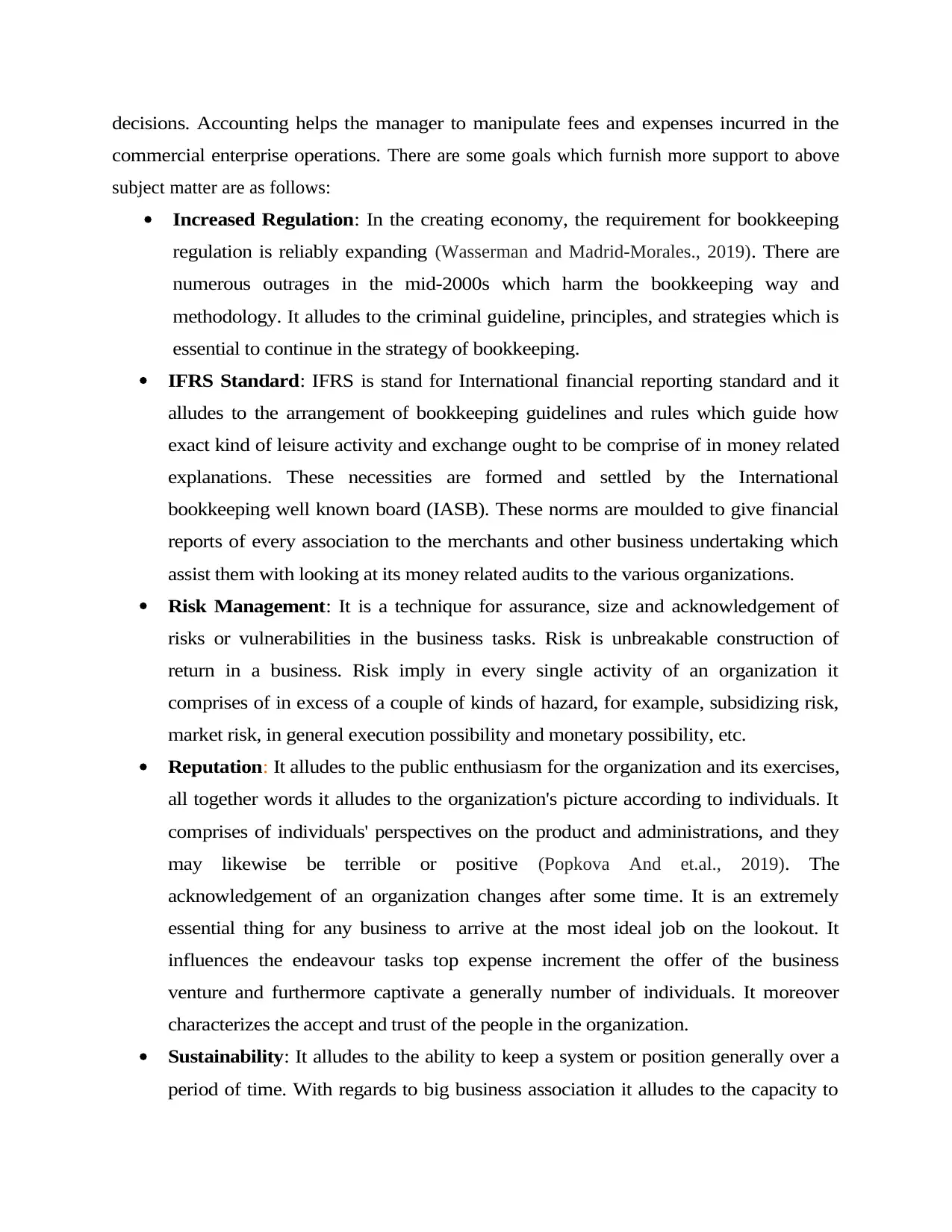
decisions. Accounting helps the manager to manipulate fees and expenses incurred in the
commercial enterprise operations. There are some goals which furnish more support to above
subject matter are as follows:
Increased Regulation: In the creating economy, the requirement for bookkeeping
regulation is reliably expanding (Wasserman and Madrid-Morales., 2019) . There are
numerous outrages in the mid-2000s which harm the bookkeeping way and
methodology. It alludes to the criminal guideline, principles, and strategies which is
essential to continue in the strategy of bookkeeping.
IFRS Standard: IFRS is stand for International financial reporting standard and it
alludes to the arrangement of bookkeeping guidelines and rules which guide how
exact kind of leisure activity and exchange ought to be comprise of in money related
explanations. These necessities are formed and settled by the International
bookkeeping well known board (IASB). These norms are moulded to give financial
reports of every association to the merchants and other business undertaking which
assist them with looking at its money related audits to the various organizations.
Risk Management: It is a technique for assurance, size and acknowledgement of
risks or vulnerabilities in the business tasks. Risk is unbreakable construction of
return in a business. Risk imply in every single activity of an organization it
comprises of in excess of a couple of kinds of hazard, for example, subsidizing risk,
market risk, in general execution possibility and monetary possibility, etc.
Reputation: It alludes to the public enthusiasm for the organization and its exercises,
all together words it alludes to the organization's picture according to individuals. It
comprises of individuals' perspectives on the product and administrations, and they
may likewise be terrible or positive (Popkova And et.al., 2019) . The
acknowledgement of an organization changes after some time. It is an extremely
essential thing for any business to arrive at the most ideal job on the lookout. It
influences the endeavour tasks top expense increment the offer of the business
venture and furthermore captivate a generally number of individuals. It moreover
characterizes the accept and trust of the people in the organization.
Sustainability: It alludes to the ability to keep a system or position generally over a
period of time. With regards to big business association it alludes to the capacity to
commercial enterprise operations. There are some goals which furnish more support to above
subject matter are as follows:
Increased Regulation: In the creating economy, the requirement for bookkeeping
regulation is reliably expanding (Wasserman and Madrid-Morales., 2019) . There are
numerous outrages in the mid-2000s which harm the bookkeeping way and
methodology. It alludes to the criminal guideline, principles, and strategies which is
essential to continue in the strategy of bookkeeping.
IFRS Standard: IFRS is stand for International financial reporting standard and it
alludes to the arrangement of bookkeeping guidelines and rules which guide how
exact kind of leisure activity and exchange ought to be comprise of in money related
explanations. These necessities are formed and settled by the International
bookkeeping well known board (IASB). These norms are moulded to give financial
reports of every association to the merchants and other business undertaking which
assist them with looking at its money related audits to the various organizations.
Risk Management: It is a technique for assurance, size and acknowledgement of
risks or vulnerabilities in the business tasks. Risk is unbreakable construction of
return in a business. Risk imply in every single activity of an organization it
comprises of in excess of a couple of kinds of hazard, for example, subsidizing risk,
market risk, in general execution possibility and monetary possibility, etc.
Reputation: It alludes to the public enthusiasm for the organization and its exercises,
all together words it alludes to the organization's picture according to individuals. It
comprises of individuals' perspectives on the product and administrations, and they
may likewise be terrible or positive (Popkova And et.al., 2019) . The
acknowledgement of an organization changes after some time. It is an extremely
essential thing for any business to arrive at the most ideal job on the lookout. It
influences the endeavour tasks top expense increment the offer of the business
venture and furthermore captivate a generally number of individuals. It moreover
characterizes the accept and trust of the people in the organization.
Sustainability: It alludes to the ability to keep a system or position generally over a
period of time. With regards to big business association it alludes to the capacity to
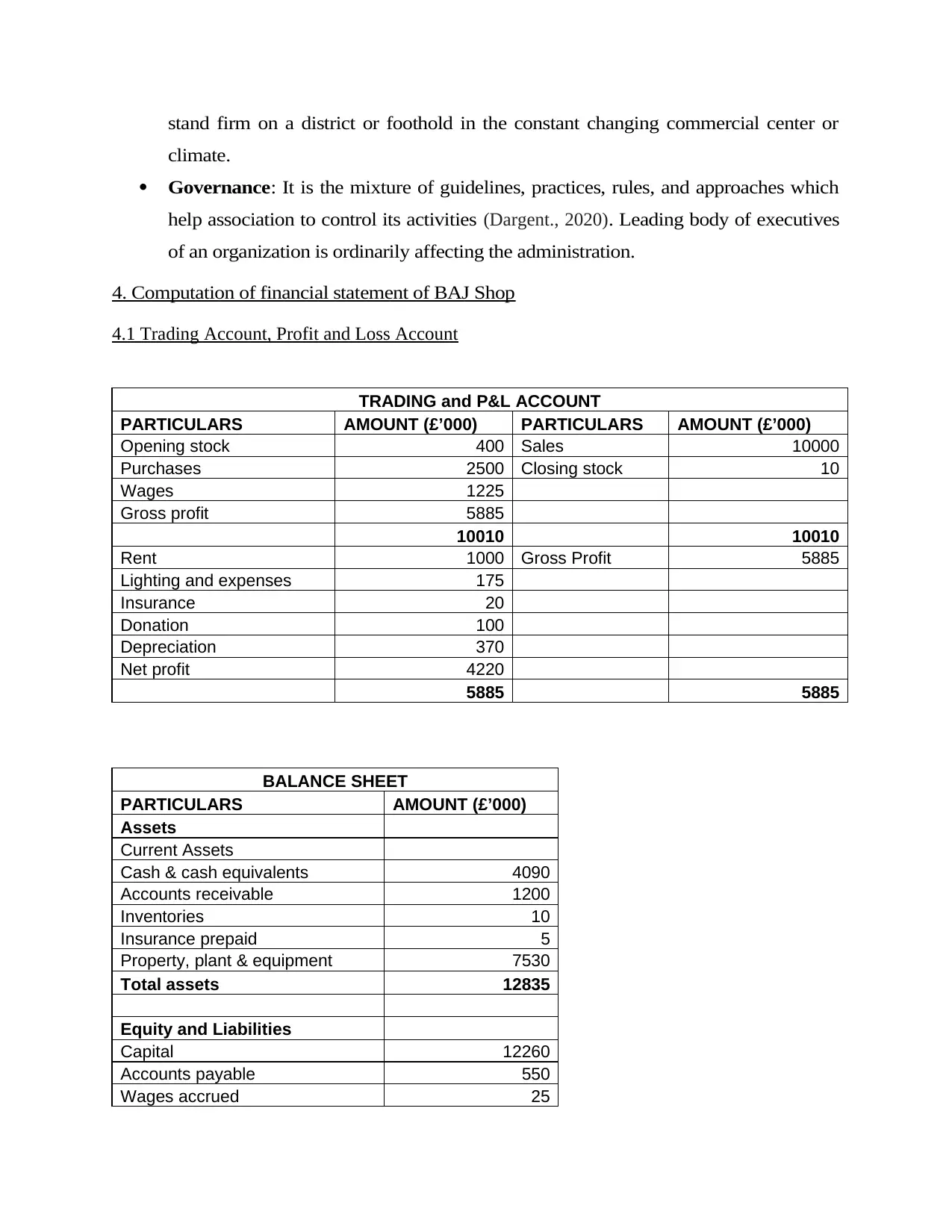
stand firm on a district or foothold in the constant changing commercial center or
climate.
Governance: It is the mixture of guidelines, practices, rules, and approaches which
help association to control its activities (Dargent., 2020) . Leading body of executives
of an organization is ordinarily affecting the administration.
4. Computation of financial statement of BAJ Shop
4.1 Trading Account, Profit and Loss Account
TRADING and P&L ACCOUNT
PARTICULARS AMOUNT (£’000) PARTICULARS AMOUNT (£’000)
Opening stock 400 Sales 10000
Purchases 2500 Closing stock 10
Wages 1225
Gross profit 5885
10010 10010
Rent 1000 Gross Profit 5885
Lighting and expenses 175
Insurance 20
Donation 100
Depreciation 370
Net profit 4220
5885 5885
BALANCE SHEET
PARTICULARS AMOUNT (£’000)
Assets
Current Assets
Cash & cash equivalents 4090
Accounts receivable 1200
Inventories 10
Insurance prepaid 5
Property, plant & equipment 7530
Total assets 12835
Equity and Liabilities
Capital 12260
Accounts payable 550
Wages accrued 25
climate.
Governance: It is the mixture of guidelines, practices, rules, and approaches which
help association to control its activities (Dargent., 2020) . Leading body of executives
of an organization is ordinarily affecting the administration.
4. Computation of financial statement of BAJ Shop
4.1 Trading Account, Profit and Loss Account
TRADING and P&L ACCOUNT
PARTICULARS AMOUNT (£’000) PARTICULARS AMOUNT (£’000)
Opening stock 400 Sales 10000
Purchases 2500 Closing stock 10
Wages 1225
Gross profit 5885
10010 10010
Rent 1000 Gross Profit 5885
Lighting and expenses 175
Insurance 20
Donation 100
Depreciation 370
Net profit 4220
5885 5885
BALANCE SHEET
PARTICULARS AMOUNT (£’000)
Assets
Current Assets
Cash & cash equivalents 4090
Accounts receivable 1200
Inventories 10
Insurance prepaid 5
Property, plant & equipment 7530
Total assets 12835
Equity and Liabilities
Capital 12260
Accounts payable 550
Wages accrued 25
⊘ This is a preview!⊘
Do you want full access?
Subscribe today to unlock all pages.

Trusted by 1+ million students worldwide
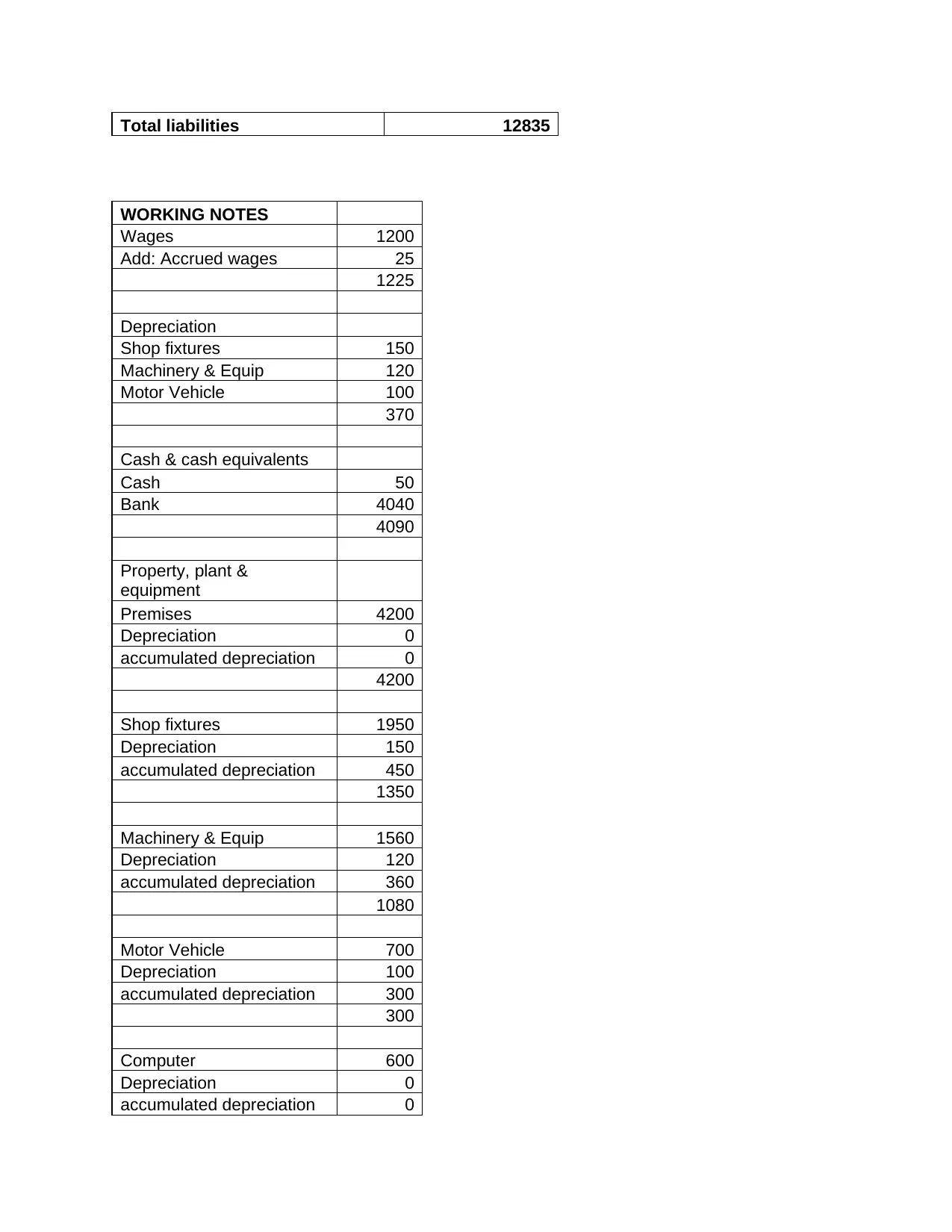
Total liabilities 12835
WORKING NOTES
Wages 1200
Add: Accrued wages 25
1225
Depreciation
Shop fixtures 150
Machinery & Equip 120
Motor Vehicle 100
370
Cash & cash equivalents
Cash 50
Bank 4040
4090
Property, plant &
equipment
Premises 4200
Depreciation 0
accumulated depreciation 0
4200
Shop fixtures 1950
Depreciation 150
accumulated depreciation 450
1350
Machinery & Equip 1560
Depreciation 120
accumulated depreciation 360
1080
Motor Vehicle 700
Depreciation 100
accumulated depreciation 300
300
Computer 600
Depreciation 0
accumulated depreciation 0
WORKING NOTES
Wages 1200
Add: Accrued wages 25
1225
Depreciation
Shop fixtures 150
Machinery & Equip 120
Motor Vehicle 100
370
Cash & cash equivalents
Cash 50
Bank 4040
4090
Property, plant &
equipment
Premises 4200
Depreciation 0
accumulated depreciation 0
4200
Shop fixtures 1950
Depreciation 150
accumulated depreciation 450
1350
Machinery & Equip 1560
Depreciation 120
accumulated depreciation 360
1080
Motor Vehicle 700
Depreciation 100
accumulated depreciation 300
300
Computer 600
Depreciation 0
accumulated depreciation 0
Paraphrase This Document
Need a fresh take? Get an instant paraphrase of this document with our AI Paraphraser
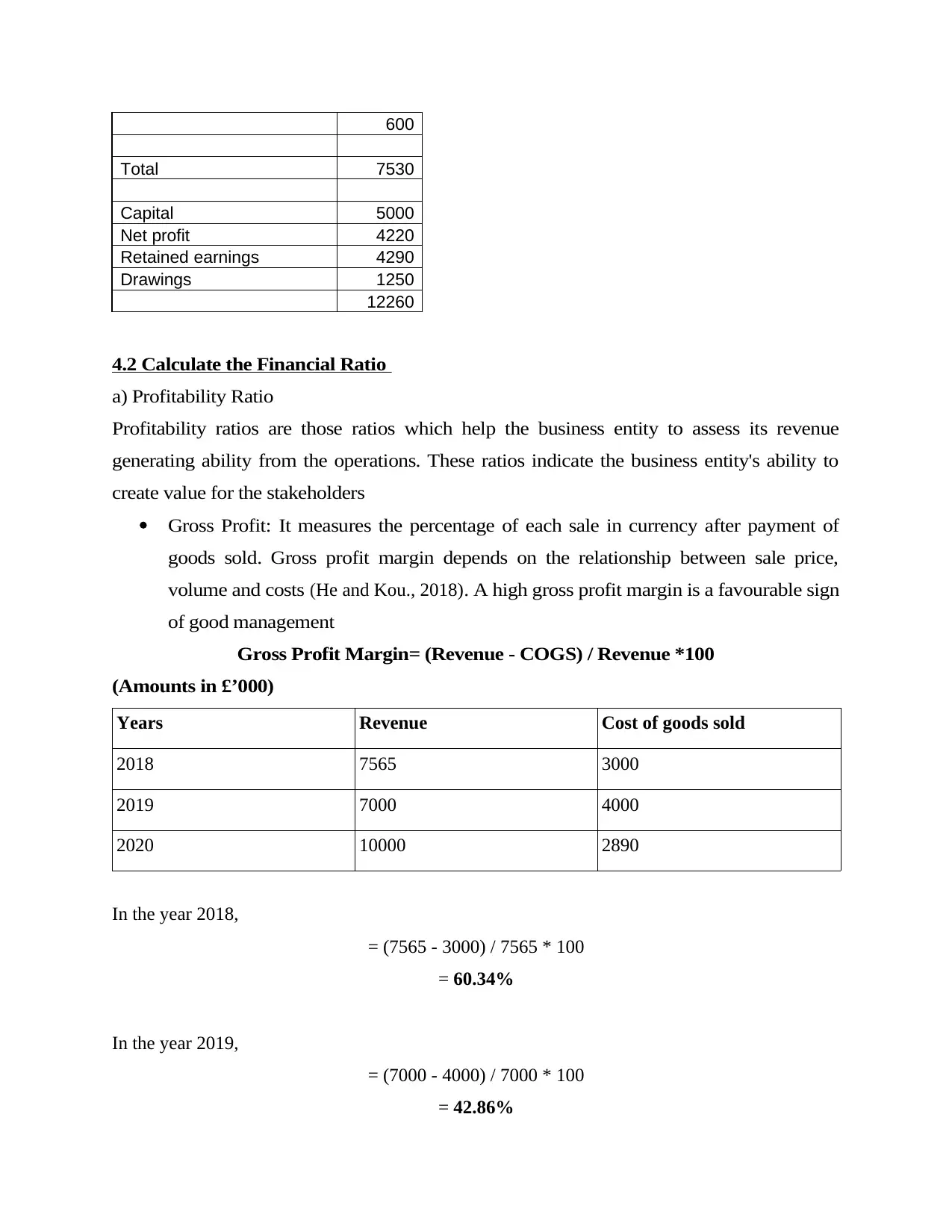
600
Total 7530
Capital 5000
Net profit 4220
Retained earnings 4290
Drawings 1250
12260
4.2 Calculate the Financial Ratio
a) Profitability Ratio
Profitability ratios are those ratios which help the business entity to assess its revenue
generating ability from the operations. These ratios indicate the business entity's ability to
create value for the stakeholders
Gross Profit: It measures the percentage of each sale in currency after payment of
goods sold. Gross profit margin depends on the relationship between sale price,
volume and costs (He and Kou., 2018) . A high gross profit margin is a favourable sign
of good management
Gross Profit Margin= (Revenue - COGS) / Revenue *100
(Amounts in £’000)
Years Revenue Cost of goods sold
2018 7565 3000
2019 7000 4000
2020 10000 2890
In the year 2018,
= (7565 - 3000) / 7565 * 100
= 60.34%
In the year 2019,
= (7000 - 4000) / 7000 * 100
= 42.86%
Total 7530
Capital 5000
Net profit 4220
Retained earnings 4290
Drawings 1250
12260
4.2 Calculate the Financial Ratio
a) Profitability Ratio
Profitability ratios are those ratios which help the business entity to assess its revenue
generating ability from the operations. These ratios indicate the business entity's ability to
create value for the stakeholders
Gross Profit: It measures the percentage of each sale in currency after payment of
goods sold. Gross profit margin depends on the relationship between sale price,
volume and costs (He and Kou., 2018) . A high gross profit margin is a favourable sign
of good management
Gross Profit Margin= (Revenue - COGS) / Revenue *100
(Amounts in £’000)
Years Revenue Cost of goods sold
2018 7565 3000
2019 7000 4000
2020 10000 2890
In the year 2018,
= (7565 - 3000) / 7565 * 100
= 60.34%
In the year 2019,
= (7000 - 4000) / 7000 * 100
= 42.86%
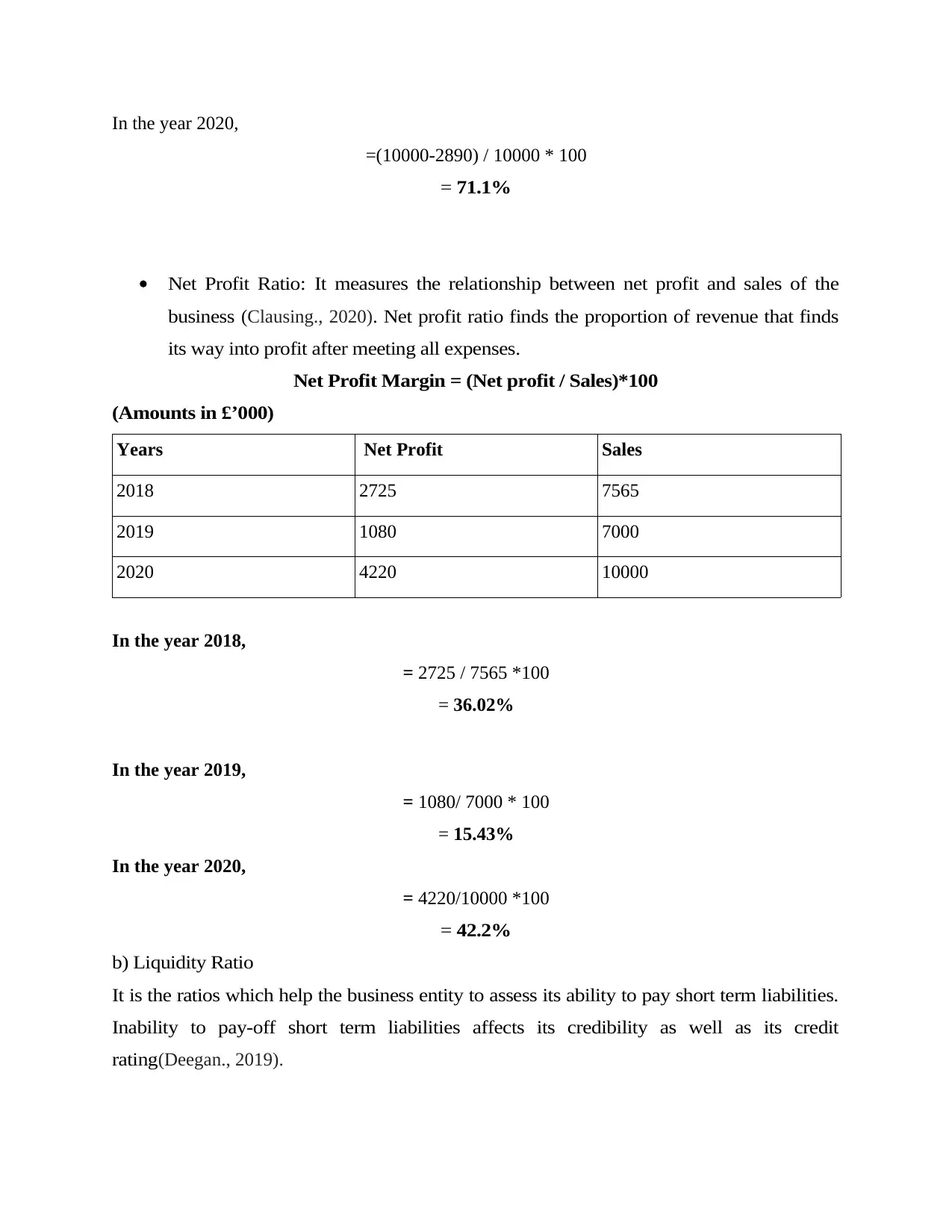
In the year 2020,
=(10000-2890) / 10000 * 100
= 71.1%
Net Profit Ratio: It measures the relationship between net profit and sales of the
business (Clausing., 2020) . Net profit ratio finds the proportion of revenue that finds
its way into profit after meeting all expenses.
Net Profit Margin = (Net profit / Sales)*100
(Amounts in £’000)
Years Net Profit Sales
2018 2725 7565
2019 1080 7000
2020 4220 10000
In the year 2018,
= 2725 / 7565 *100
= 36.02%
In the year 2019,
= 1080/ 7000 * 100
= 15.43%
In the year 2020,
= 4220/10000 *100
= 42.2%
b) Liquidity Ratio
It is the ratios which help the business entity to assess its ability to pay short term liabilities.
Inability to pay-off short term liabilities affects its credibility as well as its credit
rating(Deegan., 2019).
=(10000-2890) / 10000 * 100
= 71.1%
Net Profit Ratio: It measures the relationship between net profit and sales of the
business (Clausing., 2020) . Net profit ratio finds the proportion of revenue that finds
its way into profit after meeting all expenses.
Net Profit Margin = (Net profit / Sales)*100
(Amounts in £’000)
Years Net Profit Sales
2018 2725 7565
2019 1080 7000
2020 4220 10000
In the year 2018,
= 2725 / 7565 *100
= 36.02%
In the year 2019,
= 1080/ 7000 * 100
= 15.43%
In the year 2020,
= 4220/10000 *100
= 42.2%
b) Liquidity Ratio
It is the ratios which help the business entity to assess its ability to pay short term liabilities.
Inability to pay-off short term liabilities affects its credibility as well as its credit
rating(Deegan., 2019).
⊘ This is a preview!⊘
Do you want full access?
Subscribe today to unlock all pages.

Trusted by 1+ million students worldwide
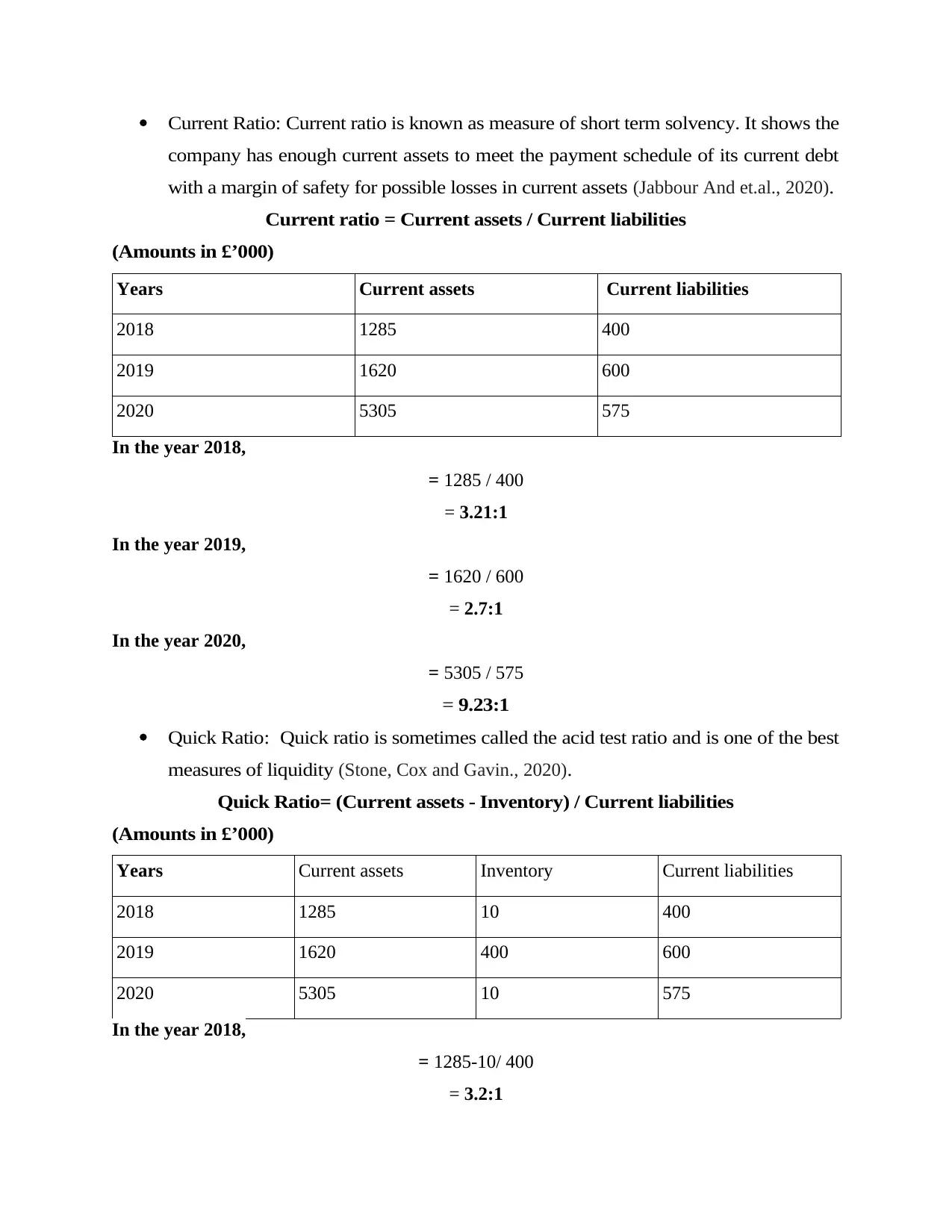
Current Ratio: Current ratio is known as measure of short term solvency. It shows the
company has enough current assets to meet the payment schedule of its current debt
with a margin of safety for possible losses in current assets (Jabbour And et.al., 2020) .
Current ratio = Current assets / Current liabilities
(Amounts in £’000)
Years Current assets Current liabilities
2018 1285 400
2019 1620 600
2020 5305 575
In the year 2018,
= 1285 / 400
= 3.21:1
In the year 2019,
= 1620 / 600
= 2.7:1
In the year 2020,
= 5305 / 575
= 9.23:1
Quick Ratio: Quick ratio is sometimes called the acid test ratio and is one of the best
measures of liquidity (Stone, Cox and Gavin., 2020) .
Quick Ratio= (Current assets - Inventory) / Current liabilities
(Amounts in £’000)
Years Current assets Inventory Current liabilities
2018 1285 10 400
2019 1620 400 600
2020 5305 10 575
In the year 2018,
= 1285-10/ 400
= 3.2:1
company has enough current assets to meet the payment schedule of its current debt
with a margin of safety for possible losses in current assets (Jabbour And et.al., 2020) .
Current ratio = Current assets / Current liabilities
(Amounts in £’000)
Years Current assets Current liabilities
2018 1285 400
2019 1620 600
2020 5305 575
In the year 2018,
= 1285 / 400
= 3.21:1
In the year 2019,
= 1620 / 600
= 2.7:1
In the year 2020,
= 5305 / 575
= 9.23:1
Quick Ratio: Quick ratio is sometimes called the acid test ratio and is one of the best
measures of liquidity (Stone, Cox and Gavin., 2020) .
Quick Ratio= (Current assets - Inventory) / Current liabilities
(Amounts in £’000)
Years Current assets Inventory Current liabilities
2018 1285 10 400
2019 1620 400 600
2020 5305 10 575
In the year 2018,
= 1285-10/ 400
= 3.2:1
Paraphrase This Document
Need a fresh take? Get an instant paraphrase of this document with our AI Paraphraser
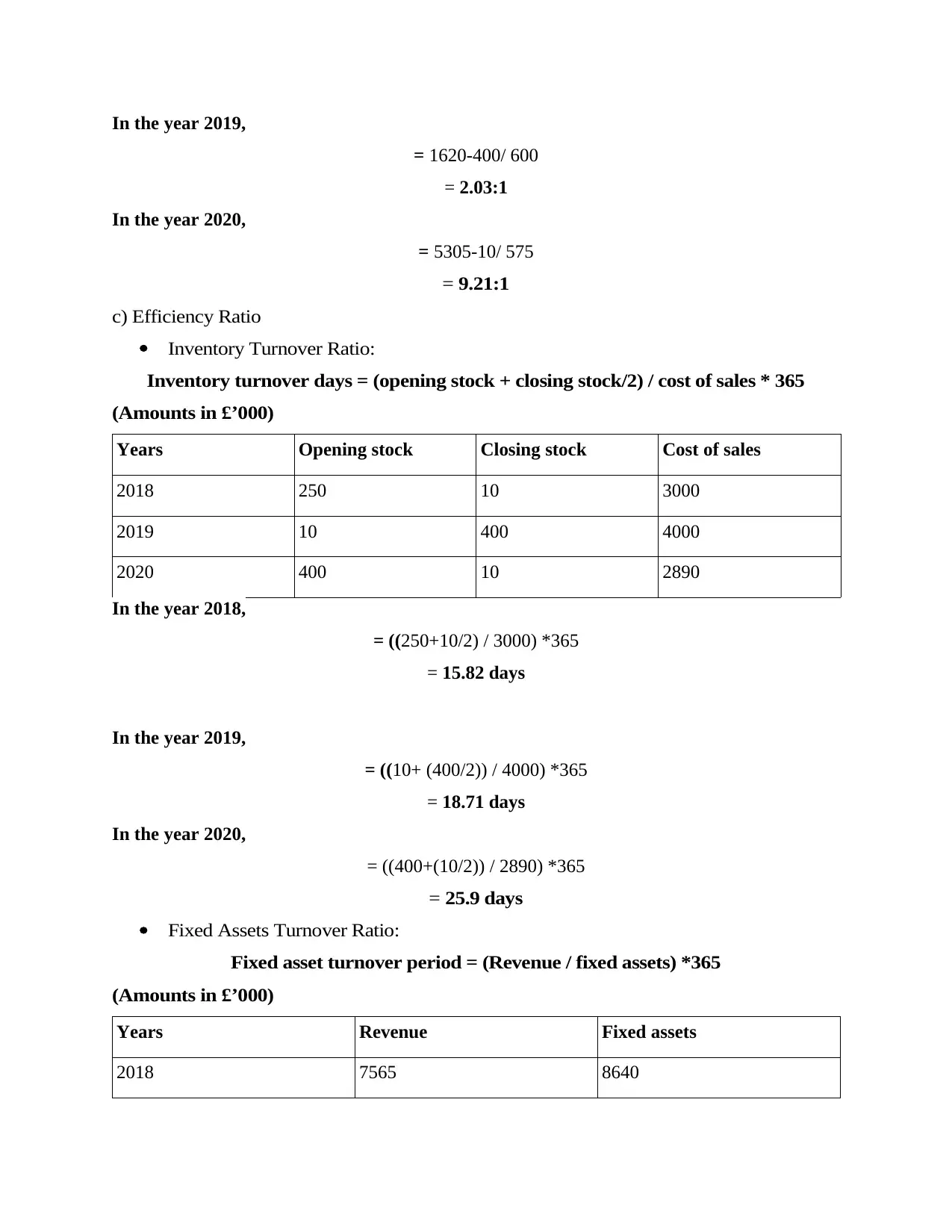
In the year 2019,
= 1620-400/ 600
= 2.03:1
In the year 2020,
= 5305-10/ 575
= 9.21:1
c) Efficiency Ratio
Inventory Turnover Ratio:
Inventory turnover days = (opening stock + closing stock/2) / cost of sales * 365
(Amounts in £’000)
Years Opening stock Closing stock Cost of sales
2018 250 10 3000
2019 10 400 4000
2020 400 10 2890
In the year 2018,
= ((250+10/2) / 3000) *365
= 15.82 days
In the year 2019,
= ((10+ (400/2)) / 4000) *365
= 18.71 days
In the year 2020,
= ((400+(10/2)) / 2890) *365
= 25.9 days
Fixed Assets Turnover Ratio:
Fixed asset turnover period = (Revenue / fixed assets) *365
(Amounts in £’000)
Years Revenue Fixed assets
2018 7565 8640
= 1620-400/ 600
= 2.03:1
In the year 2020,
= 5305-10/ 575
= 9.21:1
c) Efficiency Ratio
Inventory Turnover Ratio:
Inventory turnover days = (opening stock + closing stock/2) / cost of sales * 365
(Amounts in £’000)
Years Opening stock Closing stock Cost of sales
2018 250 10 3000
2019 10 400 4000
2020 400 10 2890
In the year 2018,
= ((250+10/2) / 3000) *365
= 15.82 days
In the year 2019,
= ((10+ (400/2)) / 4000) *365
= 18.71 days
In the year 2020,
= ((400+(10/2)) / 2890) *365
= 25.9 days
Fixed Assets Turnover Ratio:
Fixed asset turnover period = (Revenue / fixed assets) *365
(Amounts in £’000)
Years Revenue Fixed assets
2018 7565 8640
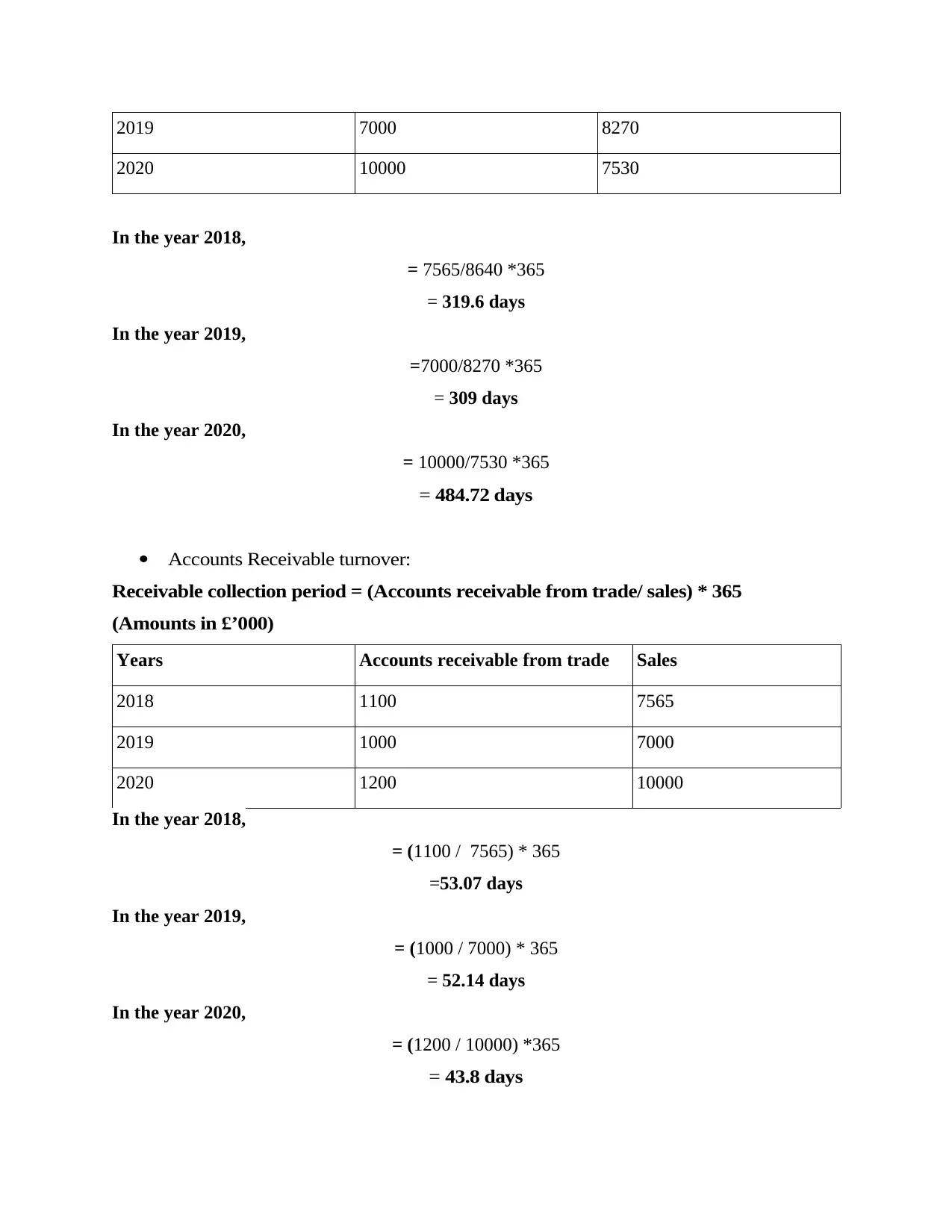
2019 7000 8270
2020 10000 7530
In the year 2018,
= 7565/8640 *365
= 319.6 days
In the year 2019,
=7000/8270 *365
= 309 days
In the year 2020,
= 10000/7530 *365
= 484.72 days
Accounts Receivable turnover:
Receivable collection period = (Accounts receivable from trade/ sales) * 365
(Amounts in £’000)
Years Accounts receivable from trade Sales
2018 1100 7565
2019 1000 7000
2020 1200 10000
In the year 2018,
= (1100 / 7565) * 365
=53.07 days
In the year 2019,
= (1000 / 7000) * 365
= 52.14 days
In the year 2020,
= (1200 / 10000) *365
= 43.8 days
2020 10000 7530
In the year 2018,
= 7565/8640 *365
= 319.6 days
In the year 2019,
=7000/8270 *365
= 309 days
In the year 2020,
= 10000/7530 *365
= 484.72 days
Accounts Receivable turnover:
Receivable collection period = (Accounts receivable from trade/ sales) * 365
(Amounts in £’000)
Years Accounts receivable from trade Sales
2018 1100 7565
2019 1000 7000
2020 1200 10000
In the year 2018,
= (1100 / 7565) * 365
=53.07 days
In the year 2019,
= (1000 / 7000) * 365
= 52.14 days
In the year 2020,
= (1200 / 10000) *365
= 43.8 days
⊘ This is a preview!⊘
Do you want full access?
Subscribe today to unlock all pages.

Trusted by 1+ million students worldwide
1 out of 19
Related Documents
Your All-in-One AI-Powered Toolkit for Academic Success.
+13062052269
info@desklib.com
Available 24*7 on WhatsApp / Email
![[object Object]](/_next/static/media/star-bottom.7253800d.svg)
Unlock your academic potential
Copyright © 2020–2025 A2Z Services. All Rights Reserved. Developed and managed by ZUCOL.



